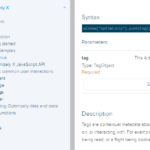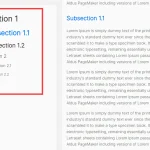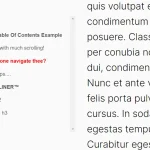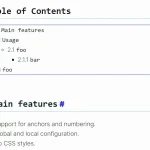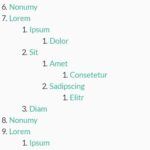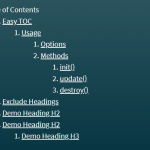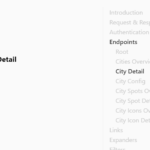| Author: | cferdinandi |
|---|---|
| Views Total: | 3,347 views |
| Official Page: | Go to website |
| Last Update: | April 2, 2020 |
| License: | MIT |
Preview:

Description:
A really simple table of contents generator to create a hierarchical in-page navigation list from heading elements found within the document.
How to use it:
1. Create a container in which the plugin generates a table of contents for your web content.
<div data-toc></div>
2. Wrap your content into a container with the data-content attribute.
<div data-content> <h2>Heading 1</h2> <p>Content</p> <h3>Heading 1-1</h3> <p>Content</p> <h4>Heading 1-1-1</h4> <p>Content</p> <h2>Heading 2</h2> <p>Content</p> ... </div>
3. Download and load the main script table-of-contents.js in the document.
<script src="table-of-contents.js"></script>
4. The JavaScript to generate a basic table of contents.
tableOfContents('[data-toc]', '[data-content]');5. The plugin automatically extracts content from heading elements and insert them into the anchor links. To customize the anchor name, assign a unique ID to your heading element as follows:
<h2 id="custom-anchor">Heading 1</h2>
6. Customize the list type used to place the anchor links. Default: unordered list.
tableOfContents('[data-toc]', '[data-content]',{
listType: 'ol'
});7. Customize the header of the table of contents.
tableOfContents('[data-toc]', '[data-content]',{
heading: 'Table of Contents',
headingLevel: 'h2'
});8. Customize the heading levels from which the plugin generates a table of contents.
tableOfContents('[data-toc]', '[data-content]',{
levels: 'h2, h3, h4, h5, h6'
});


